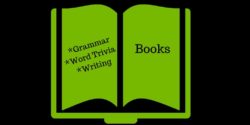I know it won’t surprise you when I tell you I am a reader. And if you read this blog post, chances are you love to read as well. I read both fiction and nonfiction, but  generally prefer books that entertain me rather than tax my brain. Do I read other writers’ grammar books? Sometimes. I have read my share of “humorous” grammar and punctuation books. books about writing, and books about words. This blog post tells you about some of those books — some I liked, some I didn’t — and next week I will tell you about the others.
generally prefer books that entertain me rather than tax my brain. Do I read other writers’ grammar books? Sometimes. I have read my share of “humorous” grammar and punctuation books. books about writing, and books about words. This blog post tells you about some of those books — some I liked, some I didn’t — and next week I will tell you about the others.
Between You & Me: Confessions of a Comma Queen – Mary Norris – Ms. Morris has great credentials. She began working at The New Yorker in 1978. Her book got a fair amount of publicity, and I was sure I would love it. What could be more fun than commas! I see that I gave it three stars on Goodreads, and I remember not being impressed. I thought I would enjoy this book more than I did. According to my short review on Goodreads, I found it tedious and I skimmed through parts. Cleverly written, but I didn’t really enjoy it. It does have four stars on Amazon. To each “their” own.
Eats, Shoots & Leaves: The Zero Tolerance Approach to Punctuation – Lynne Truss – I am not sure I had even heard about this famous book when I saw Ms. Truss on the CSpan book channel (does that still exist?). She really impressed me during that interview. I was excited about the book. Great title, but she was much more impressive, in my opinion, than the book was, not that I remember it well. I tend to forget books and movies immediately unless I am really impressed.
The Transitive Vampire: A Handbook of Grammar for the Innocent, the Eager and the Doomed – Karen Elizabeth Gordon – Another “humorous” grammar book that falls into the pile of “I don’t really remember it, but it didn’t live up to its great title.” It was a gift to me from another word person, and I had heard of it, so I was anxious to read it. Meh!
Woe Is I:The Grammarphobe’s Guide to Better English in Plain English – Patricia T. O’Conner – Okay. Even though I don’t remember its specifics, I gave it 5 stars and a short but good review; I said that I learned a few new things. Recommended.
The Gregg Reference Manual: A Manual of Style, Grammar, Usage, and Formatting – William A. Sabin – When people ask me a grammar question, I sometimes look online to see what I can find. I also head to this book. I use this book to guide my own grammar books. I have an old, spiral bound edition. I don’t know where I got it, but I love it. If you need a grammar book that is more “referency” than mine — and more comprehensive — try Gregg. Highly Recommended.
Grammar Girl – Don’t get Mignon Fogarty, known as The Grammar Girl, confused with me, The Grammar Diva. Mignon is far more famous than I, having appeared on Oprah (I think) and the Today Show, among many others. She has been around (even though she is younger) the grammar world longer than I. She has several books, her Quick and Dirty Tricks the most well-known. It is like mine in its size and coverage of grammar. She also has a famous podcast (I don’t know if she is doing it any longer) and a website with lots of sponsors and things besides grammar on it. And she really knows her stuff! I often refer to her book (I own one) when I have a question about something fairly obscure. Sometimes it is there. Most times, it isn’t because it isn’t really a think anyone writes about. Recommended (even though I consider her my main competition).
Chicago Manual of Style – The first time I laid eyes on this tome was in college, since I was a journalism major. The other tome we had was Words Into Type, which covered more graphically oriented issues. I probably still have the same copy of the Chicago Manual. Well, maybe I have a newer copy. Of course, it is the leading style manual of editors. I will say that it is a style guide and not really a grammar book; that said, I don’t know if I have ever been able to find one thing I was looking for in that index. I just don’t like that book. There are other style guides (AP, MLA, etc.), and if you are working for someone, they may ask you to use a certain one. But the Chicago Manual is the gold standard. Yuck.
Wordstruck!: The Fun and Fascination of Language – Susanna Janssen – I must admit I have read only half of my signed copy of this book. It was written by a local (Mendocino County, I believe) author, who is a a foreign language instructor. I heard her speak at my writing club. She is wonderful! And so is the book. She overlaps some of my topics when I speak, namely, word trivia. But she also delves into cultures, since that is her speciality. You will learn a lot and be very entertained. Highly Recommended.
My books – Well, you don’t think I would neglect my very own books, of which there are now about a dozen: Two basic grammar books (one with two editions), two workbooks, a confusing words book, a book of blog posts, a short grammar guidebook, a lesson plan book, a collection of three of my books…did I forget anything? Well, I do also have a novel and a self-publishing how-to book. I took that one off the market when things at Amazon changed so much. You can find my books at Amazon and all other online bookstores, and you can order them from any brick and mortar bookstore. Some libraries have it, as well as my local indie bookstore Copperfield’s. You can take a look at them on Amazon, where I have some good reviews and some….not so good, as do most books. Unfortunately, it isn’t so easy to get any reviews these days. And some of the best words about my books come from people who have blurbs on my covers and who send me nice e-mails. My books are also available in PDF form on a teacher site, Teachers Pay Teachers, where my reviews are much more excellent! My big workbook and yellow reference book are being used by many schools.
Stay tuned. Next week: more great — and not so great — books.



I hope the next installment of this article covers the dreadful, overrated Strunk and White. Hm, is my bias showing?
Oh, My gosh! I forgot about that one. YES! I will definitely include it next week. Thank you!
Great post here, Arlene. I’ve been a copy editor for some 20 years and I still read grammar books to keep up to date on the changing trends and refresh. Can’t get enough of them. Just read Ben Dryer’s book Dreyer’s English. Like that one a lot. I like to do brush-up workbooks too once a year. Any recommendations for a tune-up workbook?
Dreyer’s book is in next week’s post. I am not familiar with workbooks except my own (hint, hint). I have a small one and a large one. Either could be used for a tuneup. Thanks for the comment!
A handy guide to other guides, but why “Word/Grammar Lovers”? If you are short of space, why not use the good ol’ ampersand — i.e., “Word & Grammar Lovers”?
Speaking of the slash (/), one big lacuna I find with most grammar guides is that they totally ignore this language virus, even though it has now become the universal punctuation mark — standing in for commas, hyphens, m-dashes, and even periods — and ambiguous substitute for the conjunctions “and” and “or”. At best they simply describe the many ways it is used and abused — or do you prefer used/abused? — without giving any thought to the confusion it sows.
In any case, English isn’t German. Slashes jam words together, making them harder to read. Spaces help make written English aesthetically attractive.
Thanks for the comment. Suggestion taken.